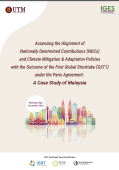This study investigates the economic viability of the Republic of Korea’s national forestation programme, which began in the 1960s and ultimately resulted in the successfully recovery of its forests and the ecosystem services associated with them. Specifically, the study estimates the changes in key ecosystem services (disaster risk reduction, carbon sequestration, water yield enhancement, and soil erosion control) from 1971 to 2010 as well as the monetary investment of forestation from 1960 to 2010.
The study found that the programme was economically viable in the long-term, with the break-even point of the extensive investment on forestation appearing within two decades. In 2010, the net present value of the forestation program was US$54.3 billion, and the benefit-cost ratio was 5.84. In particular, the benefits of disaster risk reduction (DRR) and carbon sequestration were substantial.
In addition to providing a scientific rationale for implementing forestation programs in other countries, this study highlights some key lessons from Korea’s programme that other countries could apply to maximize the probability of their success, including:
- Combine socioeconomic and environmental actions. Despite this high economic viability, just planting trees did not guarantee success of forestation. Illegal logging, slash-and-burn cultivation, and fuelwood demand also threatened the forestation programme. To address these pressures, a successful forestation program needs to increase the welfare of villagers because poverty often leads to deforestation. In the case of Korea, villagers also participated in managing nurseries, planting seedlings, and managing the planted area, supported from the governmental budget.
- Incentivize shifts to alternative, non-wood energy sources. In addition to strict regulations, the shift to other energy sources was subsidized to decrease the demand on forest wood resource.
- Choose plant species for their ecological characteristics. Fast-growing species that survive well in infertile environments were mainly planted on the degraded lands during the national forestation program. The ecological characteristics of the species rather than their economic use improved the probability of success in the forestation program.
- Conduct quantitative assessments of ecosystem services to inform policy design and implementation. Many countries underestimate economic values of forest ecosystems, not internalizing these values, owing to a lack of quantitative assessments. By quantifying ecosystem services at the temporal and spatial scales, governments can provide a stronger basis for decision-making, thereby contributing to the implementation of optimal land use and environmental policies.
- Allocate a budget for ongoing forest management. After the forestation programme concluded, consistent management was still needed to maintain the forested area. This required the allocation of appropriate national budget resources.


